Back to Page
Amazon Advertising
11 Reasons Why Your Amazon Ad Campaigns Are Not Working
11 Reasons Why Your Amazon Ad Campaigns Are Not Working
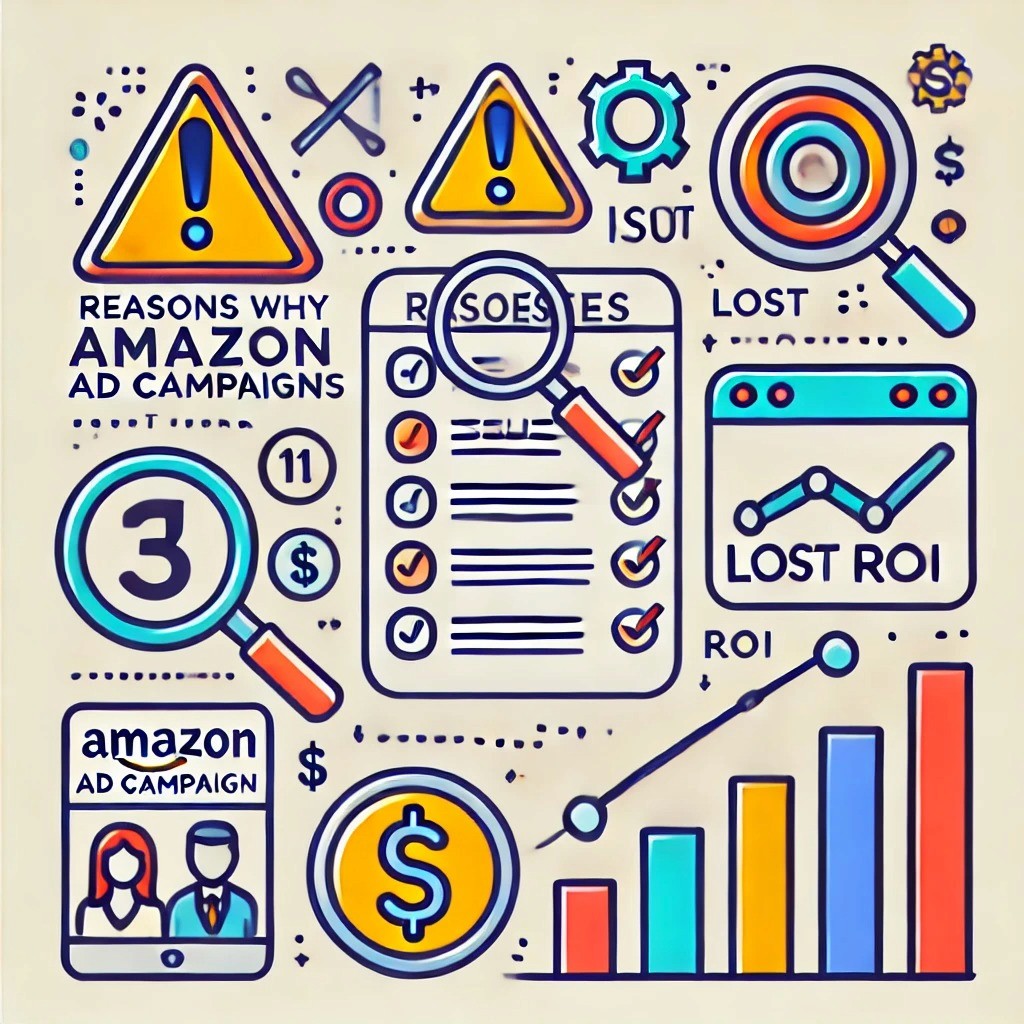

Back to Page
Amazon Advertising
11 Reasons Why Your Amazon Ad Campaigns Are Not Working

Nov 5, 2021
We know how frustrating it is to spend hundreds of dollars on your PPC campaigns only to see the graph fall flat. PPC campaigns are a great way to get an instant boost in sales, but if you are seeing inadequate results for your campaigns, chances are that you're making common mistakes that are affecting the profitability of your campaigns. In this blog post, we'll look at the most common reasons why Amazon PPC campaigns tend to fail and what needs to be done to fix them.
Reason #1: You've chosen a product that's not "retail-ready."
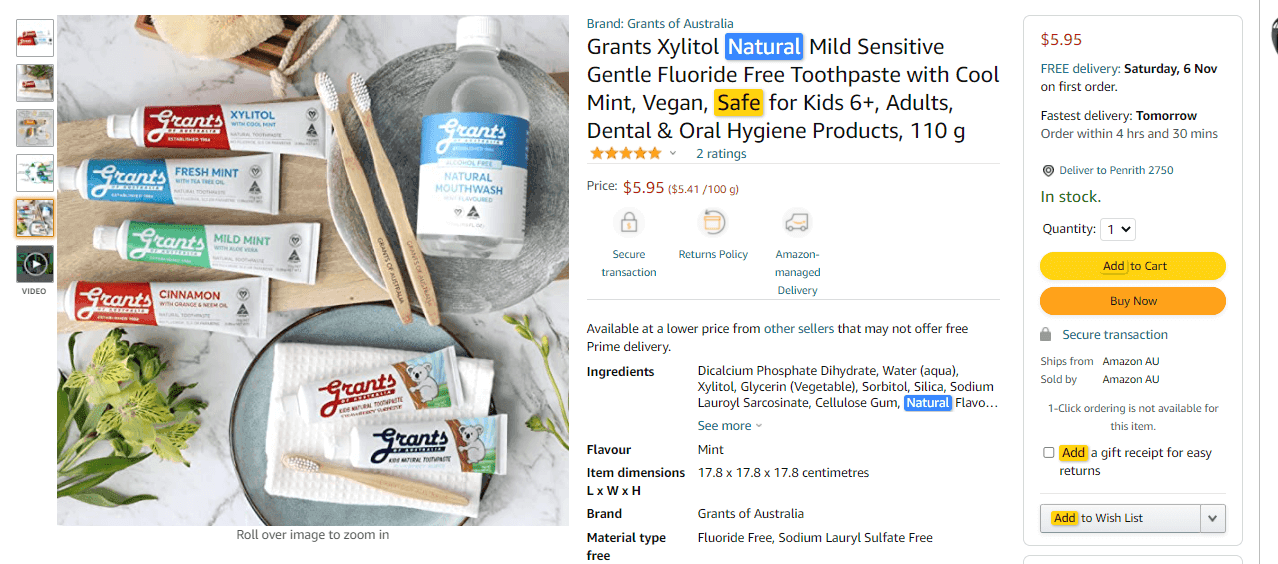
Before bringing in traffic on your product detail page, make sure it is ready for the traffic. Ready in the sense that when a shopper visits your PDP, they shouldn't be disappointed because of a lack of crucial information or out of stock labels. Amazon calls it "Retail Ready." If your ASIN isn't retail-ready, your advertising dollars will be wasted. Your product is retail-ready when the detail page contains all the information your shoppers need to make a purchase.
Here's a quick checklist of what a retail-ready product page should look like:
On-page content – easy to comprehend, informative, and SEO friendly
Images - all 9 images consisting of lifestyle and infographics
Reviews - at least 15+ verified reviews with a star rating of 3.5 or above
Buy Box - your product should always have the buy box
Stock availability - stay in stock, always
Expert tip: To make sure your product is retail ready, get it optimized from experienced Amazon product listing optimization experts.
Reason #2: You don't leverage data from automatic campaigns

We understand, that you want to have complete control over your PPC campaigns to make cost-effective decisions, but automatic campaigns are essential to test the market. You can use the search terms derived from automatic campaigns to increase the visibility of your manual campaigns. Start by setting up an automatic campaign for your product and let it run for a week. Download the search term report to get your hands on terms your shoppers use to find products like yours. Then target those terms in your manual campaigns. However, using terms from your automatic campaign does not mean you can skip the PPC keyword research part.
Expert tip:
As automatic campaigns are your "test" campaigns, please run with a minimum budget to avoid wasteful spending.
Reason #3: You don't categorize keywords by match type

Amazon allows you to filter your keywords as per broad, phrase, exact, and negative match types to refine targeting.
Broad match type casts a big net. It is the least targeted match type but can be used to improve visibility. In broad match type, words can be added in front, middle, and after your keyword. For example, if your keyword is men's shoes, your ads will show keywords like black men's shoes, men's shoes for travel, shoes for men, men's shoes size 8, etc. Couple broad match type with negative keywords to keep a tap on ACOS.
With phrase match, you can narrow down the searches and target more serious buyers. In phrase match type, words can be added before and after your keyword but not in between the words of your keyword. For example, if your keyword is men's shoes, your ads can show terms like leather men's shoes, men's shoes for office, casual men's shoes, etc.
Exact match is the most targeted match type of all and guarantees high conversion. In exact match type, your ad will show for plural version or misspelling of your keywords but not if the words are separated, or additional words are added. For example, if your keyword is formal shoes for men, your ads will show only and only for that keyword.
The key here is to filter your keywords according to their match type and use a combination of these match types to eliminate the possibility of targeting the wrong audience.
Reason #4: Your target keywords are missing from your listing copy

Amazon wants its SERPs to be as relevant as possible. So it won't show your ad if it isn't related to the search. To make sure your ads are shown on all relevant searches, add keywords targeted in your ads in your detail page copy (title, bullets, and description). Be careful not to "stuff" your copy with keywords, or it won't be appealing to read.
Reason #5: You don't add negative keywords in your campaigns
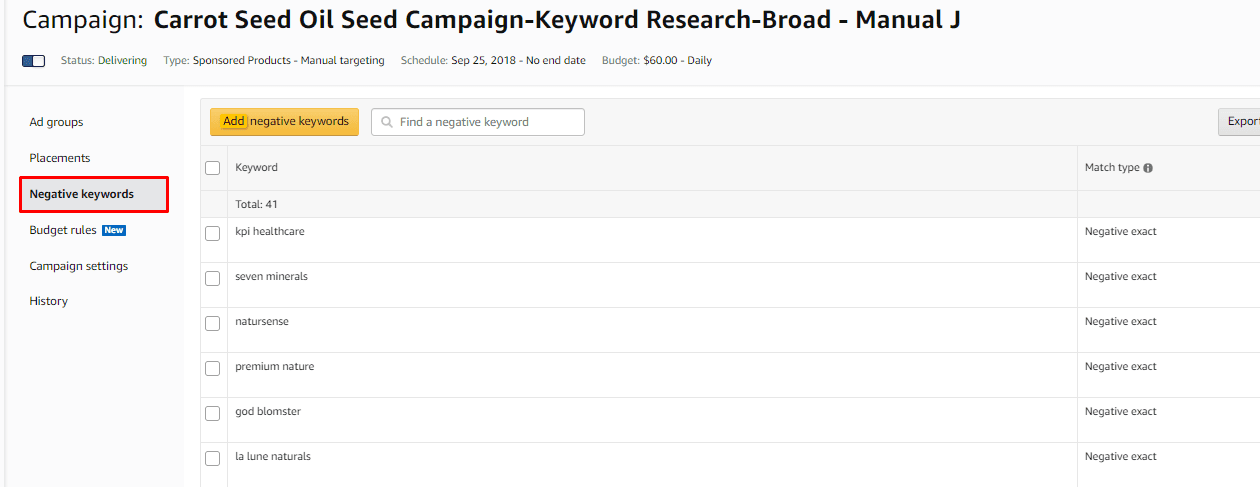
If you sell formal shoes for men, you don't want your product to show up when customers search for men's casual shoes, women's shoes, hiking shoes for men, etc. When used properly, negative keywords can help you cut down on wasted spend and reduce ACOS. While building a negative keyword list, also check your search term report regularly to find keywords that are receiving a lot of visibility but not enough conversion.
Tip:
For best results, use negative keywords as per match types.
Reason #6: You don't use long-tail keywords
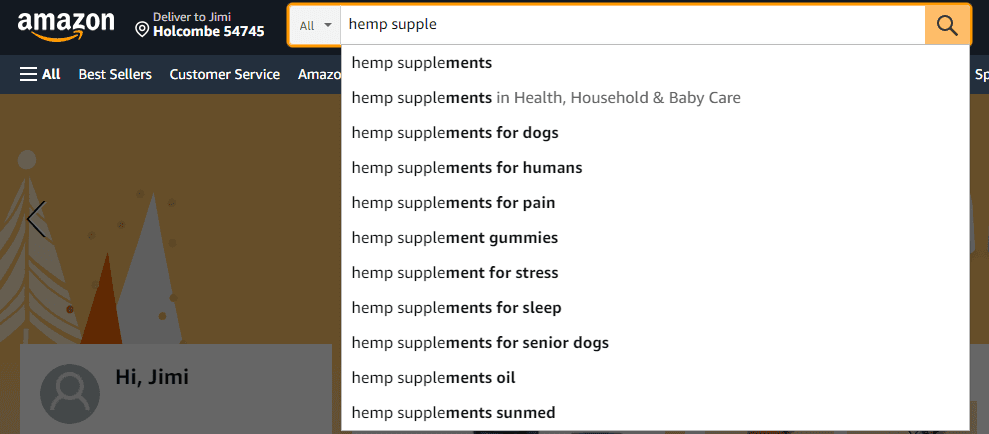
It is always easier to rank for keywords like: "black shoes for men," "size 8 shoes for men", and "men's black hiking shoes" rather than ranking for keywords like "men's shoes". The same rule applies to your PPC campaigns. If you are selling in a competitive category, you'll have a hard time getting your ad on the first page for high-volume generic terms. Long-tail keywords allow you to show your ad in front of a more serious audience who knows what they want. Resultantly, the conversion ratio of long-tail keywords is higher than any other keyword type. A shopper simply looking for "men's shoes" might be looking for any type of shoes. Maybe he needs shoes for hiking, formal parties, work, etc. But a shopper who is searching for mens black hiking shoes knows the type of shoes he needs and in the color he needs.
Expert tip:
The easiest way to build a list of negative keywords is by typing in Amazon's search bar and making a list of keywords suggested by Amazon.
Reason #7: You aren't defining your target audience

Making a keyword list and adjusting bids every day is crucial, but there's something more important. You must define your target audience because if you don't know who you're selling, you won't know which keywords to target, what type of ad copy to write, what time to run ads, and more. For example, if your target audience is stay-at-home moms, running ads all day would make more sense and if you are targeting working parents, running ads during the night or their lunch breaks will bring you better results.
Reason #8: You didn't optimize your storefront
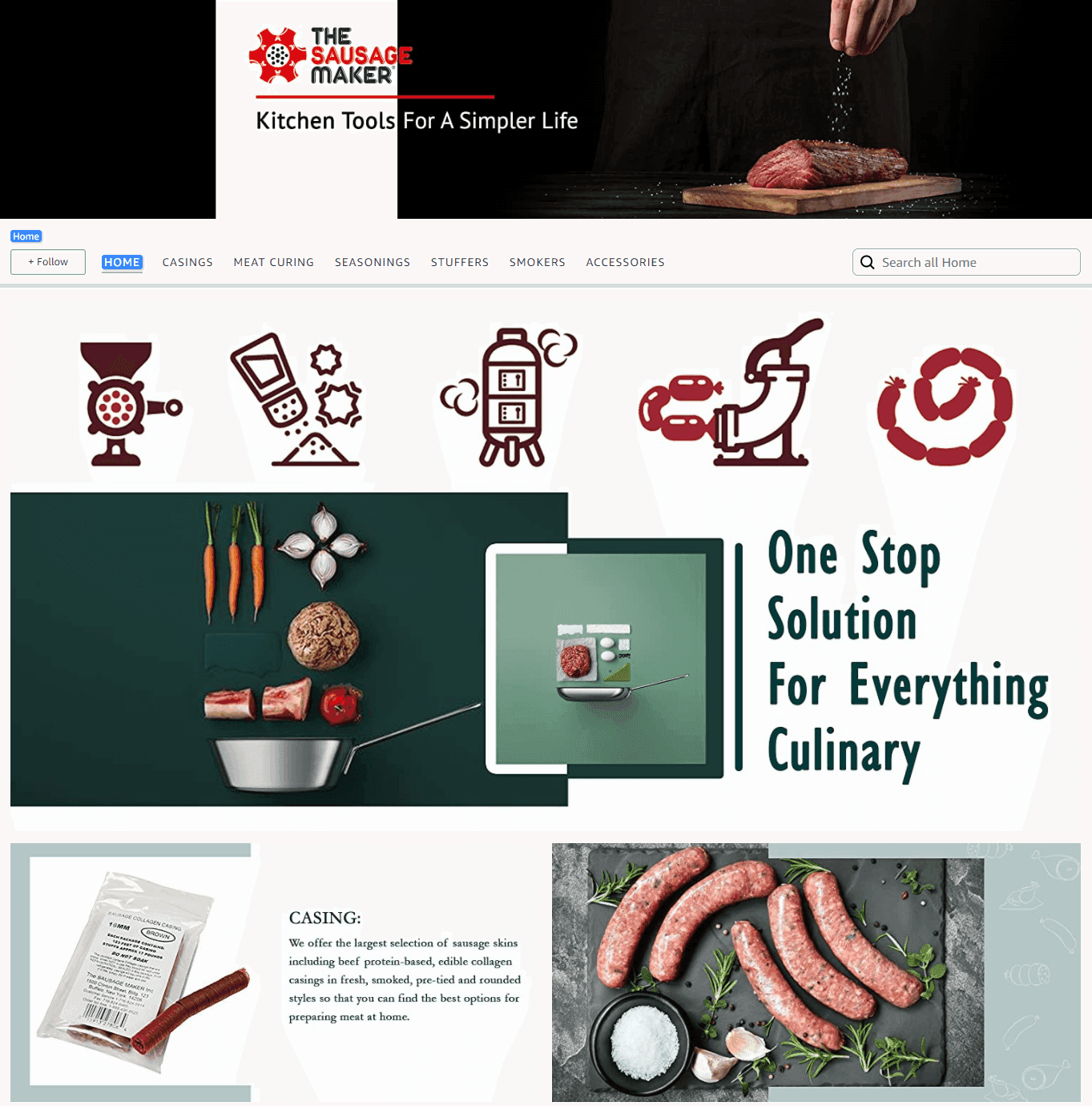
Your storefront can be a landing page for Sponsored Brand ads and just like every other landing page, it should be user-friendly, attractive, and built for conversion. Most sellers miss out on this crucial step which is why the ACOS of their Sponsored Brand ad campaigns are sky-high. Here are a few things you can do to optimize your Amazon seller storefront aka landing page of your SB campaigns:
Create a FOMO. Adding scarcity or a time limit has been shown to boost conversion by 33%.
Include a CTA. Without a call to action, your potential customers won't know what to do and where to click. Create images/banners with Buy Here, Shop Now to reduce the bounce rate.
Your storefront should be a mini-me of your website: Categorize your products, add a logo to your header, create larger than life lifestyle images and hero banners, and make sure your store helps increase brand recall.
Seal the deal with the social proof: People prefer to buy brands with a good track record. Include a section in your storefront that highlights your reviews. We prefer to use the "Gallery" module of the storefront to feature the best reviews received on the products. Just be sure to use original, authentic reviews you've received on your Amazon detail page along with the name of the reviewer.
Less text, more visuals: Nothing turns off buyers more than busy, cluttered designs. A shopper's attention span is less than 8 seconds and you need to make sure you are not overwhelming your shoppers with too much information. Use shorter yet eye-catching taglines, add bullets to make information skimmable, and add a mix of videos and images to keep the shoppers glued.
Reason #9: You aren't leveraging video ads

According to HubSpot, 68% of shoppers prefer to learn about new products via video. About 84% of the shoppers say that they are convinced about buying a product or service after watching the brand's video, while 66% of the shoppers prefer watching a video instead of reading boring descriptions. So it makes complete sense to include Sponsored Brand Video ads in your advertising mix. Even if we take into account the money you spend in making a product video from scratch, the benefits of video ads make it all worth it. Video ads are said to have scroll-stopping power and are one of the most impactful forms of advertisement with the highest CTR.
Here's how you can make videos that convert and compel the customers to click:
Define your goals. If your goal is brand awareness, your video should focus on your brand, its ethics, and your brand story. If your goal is to increase sales, your video should be product-focused
Your video should not be longer than 15-30 seconds
Include a call to action and your brand logo
Make sure your video looks equally great when viewed on smaller screens
Your video should be relevant even when mute
Reason #10: You weren't patient with your campaigns
As a general rule of thumb, you should wait for at least 7 days to make any changes in your campaign. Use features like budget caps to prevent your campaign from overspending.
Reason #11: You don't optimize your campaigns every day
Whether you are running campaigns for 5 products or 500 products, you must optimize your campaigns every day, even if that means adjusting a couple of bids. Keeping a close watch on your campaign will help you avoid surprises. While optimizing your campaigns, analyze the following metrics:
Budget: Make sure none of your campaigns are out of budget. If you have a limited budget focus, just shift your budget focus towards high-performing campaigns. If your budget is underutilized, there is an opportunity to increase visibility.
Keywords: Remove underperforming keywords, add negative keywords, and add profitable search terms.
Bids: Reduce bids on low-performing keywords, and increase bids on high-performing keywords.
Sounds like too much work? There are a lot of factors that affect the profitability of your PPC campaigns and getting all the stuff right is tough. The good news is; that you can get help from one of the Top Amazon PPC Agencies to optimize and manage your Amazon PPC campaign. We take the hassle out of PPC and make sure your PPC campaigns work for you, not the other way around.
We know how frustrating it is to spend hundreds of dollars on your PPC campaigns only to see the graph fall flat. PPC campaigns are a great way to get an instant boost in sales, but if you are seeing inadequate results for your campaigns, chances are that you're making common mistakes that are affecting the profitability of your campaigns. In this blog post, we'll look at the most common reasons why Amazon PPC campaigns tend to fail and what needs to be done to fix them.
Reason #1: You've chosen a product that's not "retail-ready."

Before bringing in traffic on your product detail page, make sure it is ready for the traffic. Ready in the sense that when a shopper visits your PDP, they shouldn't be disappointed because of a lack of crucial information or out of stock labels. Amazon calls it "Retail Ready." If your ASIN isn't retail-ready, your advertising dollars will be wasted. Your product is retail-ready when the detail page contains all the information your shoppers need to make a purchase.
Here's a quick checklist of what a retail-ready product page should look like:
On-page content – easy to comprehend, informative, and SEO friendly
Images - all 9 images consisting of lifestyle and infographics
Reviews - at least 15+ verified reviews with a star rating of 3.5 or above
Buy Box - your product should always have the buy box
Stock availability - stay in stock, always
Expert tip: To make sure your product is retail ready, get it optimized from experienced Amazon product listing optimization experts.
Reason #2: You don't leverage data from automatic campaigns

We understand, that you want to have complete control over your PPC campaigns to make cost-effective decisions, but automatic campaigns are essential to test the market. You can use the search terms derived from automatic campaigns to increase the visibility of your manual campaigns. Start by setting up an automatic campaign for your product and let it run for a week. Download the search term report to get your hands on terms your shoppers use to find products like yours. Then target those terms in your manual campaigns. However, using terms from your automatic campaign does not mean you can skip the PPC keyword research part.
Expert tip:
As automatic campaigns are your "test" campaigns, please run with a minimum budget to avoid wasteful spending.
Reason #3: You don't categorize keywords by match type

Amazon allows you to filter your keywords as per broad, phrase, exact, and negative match types to refine targeting.
Broad match type casts a big net. It is the least targeted match type but can be used to improve visibility. In broad match type, words can be added in front, middle, and after your keyword. For example, if your keyword is men's shoes, your ads will show keywords like black men's shoes, men's shoes for travel, shoes for men, men's shoes size 8, etc. Couple broad match type with negative keywords to keep a tap on ACOS.
With phrase match, you can narrow down the searches and target more serious buyers. In phrase match type, words can be added before and after your keyword but not in between the words of your keyword. For example, if your keyword is men's shoes, your ads can show terms like leather men's shoes, men's shoes for office, casual men's shoes, etc.
Exact match is the most targeted match type of all and guarantees high conversion. In exact match type, your ad will show for plural version or misspelling of your keywords but not if the words are separated, or additional words are added. For example, if your keyword is formal shoes for men, your ads will show only and only for that keyword.
The key here is to filter your keywords according to their match type and use a combination of these match types to eliminate the possibility of targeting the wrong audience.
Reason #4: Your target keywords are missing from your listing copy

Amazon wants its SERPs to be as relevant as possible. So it won't show your ad if it isn't related to the search. To make sure your ads are shown on all relevant searches, add keywords targeted in your ads in your detail page copy (title, bullets, and description). Be careful not to "stuff" your copy with keywords, or it won't be appealing to read.
Reason #5: You don't add negative keywords in your campaigns

If you sell formal shoes for men, you don't want your product to show up when customers search for men's casual shoes, women's shoes, hiking shoes for men, etc. When used properly, negative keywords can help you cut down on wasted spend and reduce ACOS. While building a negative keyword list, also check your search term report regularly to find keywords that are receiving a lot of visibility but not enough conversion.
Tip:
For best results, use negative keywords as per match types.
Reason #6: You don't use long-tail keywords

It is always easier to rank for keywords like: "black shoes for men," "size 8 shoes for men", and "men's black hiking shoes" rather than ranking for keywords like "men's shoes". The same rule applies to your PPC campaigns. If you are selling in a competitive category, you'll have a hard time getting your ad on the first page for high-volume generic terms. Long-tail keywords allow you to show your ad in front of a more serious audience who knows what they want. Resultantly, the conversion ratio of long-tail keywords is higher than any other keyword type. A shopper simply looking for "men's shoes" might be looking for any type of shoes. Maybe he needs shoes for hiking, formal parties, work, etc. But a shopper who is searching for mens black hiking shoes knows the type of shoes he needs and in the color he needs.
Expert tip:
The easiest way to build a list of negative keywords is by typing in Amazon's search bar and making a list of keywords suggested by Amazon.
Reason #7: You aren't defining your target audience

Making a keyword list and adjusting bids every day is crucial, but there's something more important. You must define your target audience because if you don't know who you're selling, you won't know which keywords to target, what type of ad copy to write, what time to run ads, and more. For example, if your target audience is stay-at-home moms, running ads all day would make more sense and if you are targeting working parents, running ads during the night or their lunch breaks will bring you better results.
Reason #8: You didn't optimize your storefront

Your storefront can be a landing page for Sponsored Brand ads and just like every other landing page, it should be user-friendly, attractive, and built for conversion. Most sellers miss out on this crucial step which is why the ACOS of their Sponsored Brand ad campaigns are sky-high. Here are a few things you can do to optimize your Amazon seller storefront aka landing page of your SB campaigns:
Create a FOMO. Adding scarcity or a time limit has been shown to boost conversion by 33%.
Include a CTA. Without a call to action, your potential customers won't know what to do and where to click. Create images/banners with Buy Here, Shop Now to reduce the bounce rate.
Your storefront should be a mini-me of your website: Categorize your products, add a logo to your header, create larger than life lifestyle images and hero banners, and make sure your store helps increase brand recall.
Seal the deal with the social proof: People prefer to buy brands with a good track record. Include a section in your storefront that highlights your reviews. We prefer to use the "Gallery" module of the storefront to feature the best reviews received on the products. Just be sure to use original, authentic reviews you've received on your Amazon detail page along with the name of the reviewer.
Less text, more visuals: Nothing turns off buyers more than busy, cluttered designs. A shopper's attention span is less than 8 seconds and you need to make sure you are not overwhelming your shoppers with too much information. Use shorter yet eye-catching taglines, add bullets to make information skimmable, and add a mix of videos and images to keep the shoppers glued.
Reason #9: You aren't leveraging video ads

According to HubSpot, 68% of shoppers prefer to learn about new products via video. About 84% of the shoppers say that they are convinced about buying a product or service after watching the brand's video, while 66% of the shoppers prefer watching a video instead of reading boring descriptions. So it makes complete sense to include Sponsored Brand Video ads in your advertising mix. Even if we take into account the money you spend in making a product video from scratch, the benefits of video ads make it all worth it. Video ads are said to have scroll-stopping power and are one of the most impactful forms of advertisement with the highest CTR.
Here's how you can make videos that convert and compel the customers to click:
Define your goals. If your goal is brand awareness, your video should focus on your brand, its ethics, and your brand story. If your goal is to increase sales, your video should be product-focused
Your video should not be longer than 15-30 seconds
Include a call to action and your brand logo
Make sure your video looks equally great when viewed on smaller screens
Your video should be relevant even when mute
Reason #10: You weren't patient with your campaigns
As a general rule of thumb, you should wait for at least 7 days to make any changes in your campaign. Use features like budget caps to prevent your campaign from overspending.
Reason #11: You don't optimize your campaigns every day
Whether you are running campaigns for 5 products or 500 products, you must optimize your campaigns every day, even if that means adjusting a couple of bids. Keeping a close watch on your campaign will help you avoid surprises. While optimizing your campaigns, analyze the following metrics:
Budget: Make sure none of your campaigns are out of budget. If you have a limited budget focus, just shift your budget focus towards high-performing campaigns. If your budget is underutilized, there is an opportunity to increase visibility.
Keywords: Remove underperforming keywords, add negative keywords, and add profitable search terms.
Bids: Reduce bids on low-performing keywords, and increase bids on high-performing keywords.
Sounds like too much work? There are a lot of factors that affect the profitability of your PPC campaigns and getting all the stuff right is tough. The good news is; that you can get help from one of the Top Amazon PPC Agencies to optimize and manage your Amazon PPC campaign. We take the hassle out of PPC and make sure your PPC campaigns work for you, not the other way around.
We know how frustrating it is to spend hundreds of dollars on your PPC campaigns only to see the graph fall flat. PPC campaigns are a great way to get an instant boost in sales, but if you are seeing inadequate results for your campaigns, chances are that you're making common mistakes that are affecting the profitability of your campaigns. In this blog post, we'll look at the most common reasons why Amazon PPC campaigns tend to fail and what needs to be done to fix them.
Reason #1: You've chosen a product that's not "retail-ready."

Before bringing in traffic on your product detail page, make sure it is ready for the traffic. Ready in the sense that when a shopper visits your PDP, they shouldn't be disappointed because of a lack of crucial information or out of stock labels. Amazon calls it "Retail Ready." If your ASIN isn't retail-ready, your advertising dollars will be wasted. Your product is retail-ready when the detail page contains all the information your shoppers need to make a purchase.
Here's a quick checklist of what a retail-ready product page should look like:
On-page content – easy to comprehend, informative, and SEO friendly
Images - all 9 images consisting of lifestyle and infographics
Reviews - at least 15+ verified reviews with a star rating of 3.5 or above
Buy Box - your product should always have the buy box
Stock availability - stay in stock, always
Expert tip: To make sure your product is retail ready, get it optimized from experienced Amazon product listing optimization experts.
Reason #2: You don't leverage data from automatic campaigns

We understand, that you want to have complete control over your PPC campaigns to make cost-effective decisions, but automatic campaigns are essential to test the market. You can use the search terms derived from automatic campaigns to increase the visibility of your manual campaigns. Start by setting up an automatic campaign for your product and let it run for a week. Download the search term report to get your hands on terms your shoppers use to find products like yours. Then target those terms in your manual campaigns. However, using terms from your automatic campaign does not mean you can skip the PPC keyword research part.
Expert tip:
As automatic campaigns are your "test" campaigns, please run with a minimum budget to avoid wasteful spending.
Reason #3: You don't categorize keywords by match type

Amazon allows you to filter your keywords as per broad, phrase, exact, and negative match types to refine targeting.
Broad match type casts a big net. It is the least targeted match type but can be used to improve visibility. In broad match type, words can be added in front, middle, and after your keyword. For example, if your keyword is men's shoes, your ads will show keywords like black men's shoes, men's shoes for travel, shoes for men, men's shoes size 8, etc. Couple broad match type with negative keywords to keep a tap on ACOS.
With phrase match, you can narrow down the searches and target more serious buyers. In phrase match type, words can be added before and after your keyword but not in between the words of your keyword. For example, if your keyword is men's shoes, your ads can show terms like leather men's shoes, men's shoes for office, casual men's shoes, etc.
Exact match is the most targeted match type of all and guarantees high conversion. In exact match type, your ad will show for plural version or misspelling of your keywords but not if the words are separated, or additional words are added. For example, if your keyword is formal shoes for men, your ads will show only and only for that keyword.
The key here is to filter your keywords according to their match type and use a combination of these match types to eliminate the possibility of targeting the wrong audience.
Reason #4: Your target keywords are missing from your listing copy

Amazon wants its SERPs to be as relevant as possible. So it won't show your ad if it isn't related to the search. To make sure your ads are shown on all relevant searches, add keywords targeted in your ads in your detail page copy (title, bullets, and description). Be careful not to "stuff" your copy with keywords, or it won't be appealing to read.
Reason #5: You don't add negative keywords in your campaigns

If you sell formal shoes for men, you don't want your product to show up when customers search for men's casual shoes, women's shoes, hiking shoes for men, etc. When used properly, negative keywords can help you cut down on wasted spend and reduce ACOS. While building a negative keyword list, also check your search term report regularly to find keywords that are receiving a lot of visibility but not enough conversion.
Tip:
For best results, use negative keywords as per match types.
Reason #6: You don't use long-tail keywords

It is always easier to rank for keywords like: "black shoes for men," "size 8 shoes for men", and "men's black hiking shoes" rather than ranking for keywords like "men's shoes". The same rule applies to your PPC campaigns. If you are selling in a competitive category, you'll have a hard time getting your ad on the first page for high-volume generic terms. Long-tail keywords allow you to show your ad in front of a more serious audience who knows what they want. Resultantly, the conversion ratio of long-tail keywords is higher than any other keyword type. A shopper simply looking for "men's shoes" might be looking for any type of shoes. Maybe he needs shoes for hiking, formal parties, work, etc. But a shopper who is searching for mens black hiking shoes knows the type of shoes he needs and in the color he needs.
Expert tip:
The easiest way to build a list of negative keywords is by typing in Amazon's search bar and making a list of keywords suggested by Amazon.
Reason #7: You aren't defining your target audience

Making a keyword list and adjusting bids every day is crucial, but there's something more important. You must define your target audience because if you don't know who you're selling, you won't know which keywords to target, what type of ad copy to write, what time to run ads, and more. For example, if your target audience is stay-at-home moms, running ads all day would make more sense and if you are targeting working parents, running ads during the night or their lunch breaks will bring you better results.
Reason #8: You didn't optimize your storefront

Your storefront can be a landing page for Sponsored Brand ads and just like every other landing page, it should be user-friendly, attractive, and built for conversion. Most sellers miss out on this crucial step which is why the ACOS of their Sponsored Brand ad campaigns are sky-high. Here are a few things you can do to optimize your Amazon seller storefront aka landing page of your SB campaigns:
Create a FOMO. Adding scarcity or a time limit has been shown to boost conversion by 33%.
Include a CTA. Without a call to action, your potential customers won't know what to do and where to click. Create images/banners with Buy Here, Shop Now to reduce the bounce rate.
Your storefront should be a mini-me of your website: Categorize your products, add a logo to your header, create larger than life lifestyle images and hero banners, and make sure your store helps increase brand recall.
Seal the deal with the social proof: People prefer to buy brands with a good track record. Include a section in your storefront that highlights your reviews. We prefer to use the "Gallery" module of the storefront to feature the best reviews received on the products. Just be sure to use original, authentic reviews you've received on your Amazon detail page along with the name of the reviewer.
Less text, more visuals: Nothing turns off buyers more than busy, cluttered designs. A shopper's attention span is less than 8 seconds and you need to make sure you are not overwhelming your shoppers with too much information. Use shorter yet eye-catching taglines, add bullets to make information skimmable, and add a mix of videos and images to keep the shoppers glued.
Reason #9: You aren't leveraging video ads

According to HubSpot, 68% of shoppers prefer to learn about new products via video. About 84% of the shoppers say that they are convinced about buying a product or service after watching the brand's video, while 66% of the shoppers prefer watching a video instead of reading boring descriptions. So it makes complete sense to include Sponsored Brand Video ads in your advertising mix. Even if we take into account the money you spend in making a product video from scratch, the benefits of video ads make it all worth it. Video ads are said to have scroll-stopping power and are one of the most impactful forms of advertisement with the highest CTR.
Here's how you can make videos that convert and compel the customers to click:
Define your goals. If your goal is brand awareness, your video should focus on your brand, its ethics, and your brand story. If your goal is to increase sales, your video should be product-focused
Your video should not be longer than 15-30 seconds
Include a call to action and your brand logo
Make sure your video looks equally great when viewed on smaller screens
Your video should be relevant even when mute
Reason #10: You weren't patient with your campaigns
As a general rule of thumb, you should wait for at least 7 days to make any changes in your campaign. Use features like budget caps to prevent your campaign from overspending.
Reason #11: You don't optimize your campaigns every day
Whether you are running campaigns for 5 products or 500 products, you must optimize your campaigns every day, even if that means adjusting a couple of bids. Keeping a close watch on your campaign will help you avoid surprises. While optimizing your campaigns, analyze the following metrics:
Budget: Make sure none of your campaigns are out of budget. If you have a limited budget focus, just shift your budget focus towards high-performing campaigns. If your budget is underutilized, there is an opportunity to increase visibility.
Keywords: Remove underperforming keywords, add negative keywords, and add profitable search terms.
Bids: Reduce bids on low-performing keywords, and increase bids on high-performing keywords.
Sounds like too much work? There are a lot of factors that affect the profitability of your PPC campaigns and getting all the stuff right is tough. The good news is; that you can get help from one of the Top Amazon PPC Agencies to optimize and manage your Amazon PPC campaign. We take the hassle out of PPC and make sure your PPC campaigns work for you, not the other way around.









